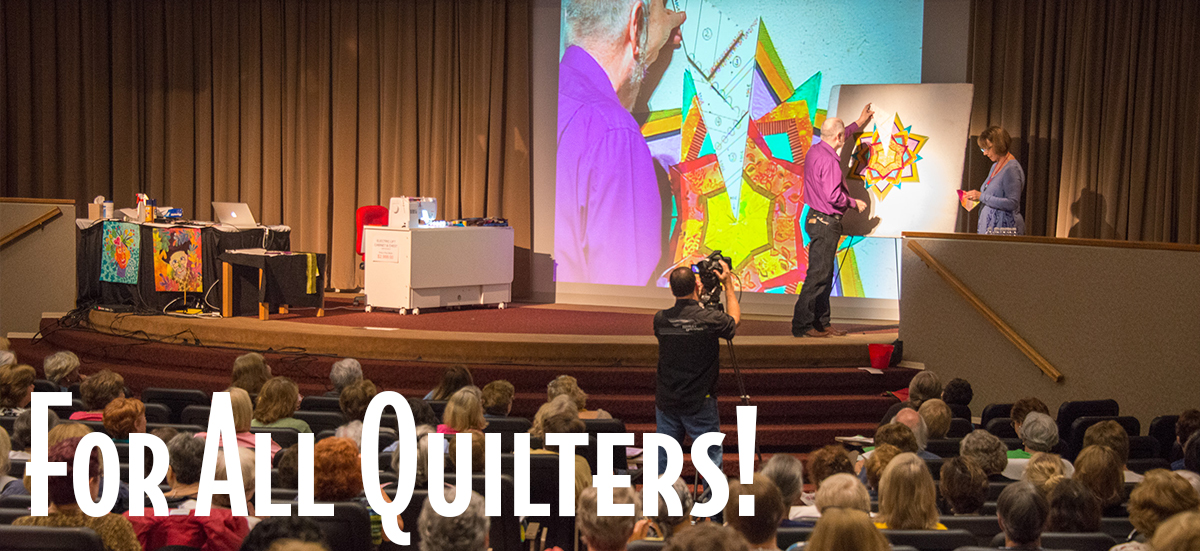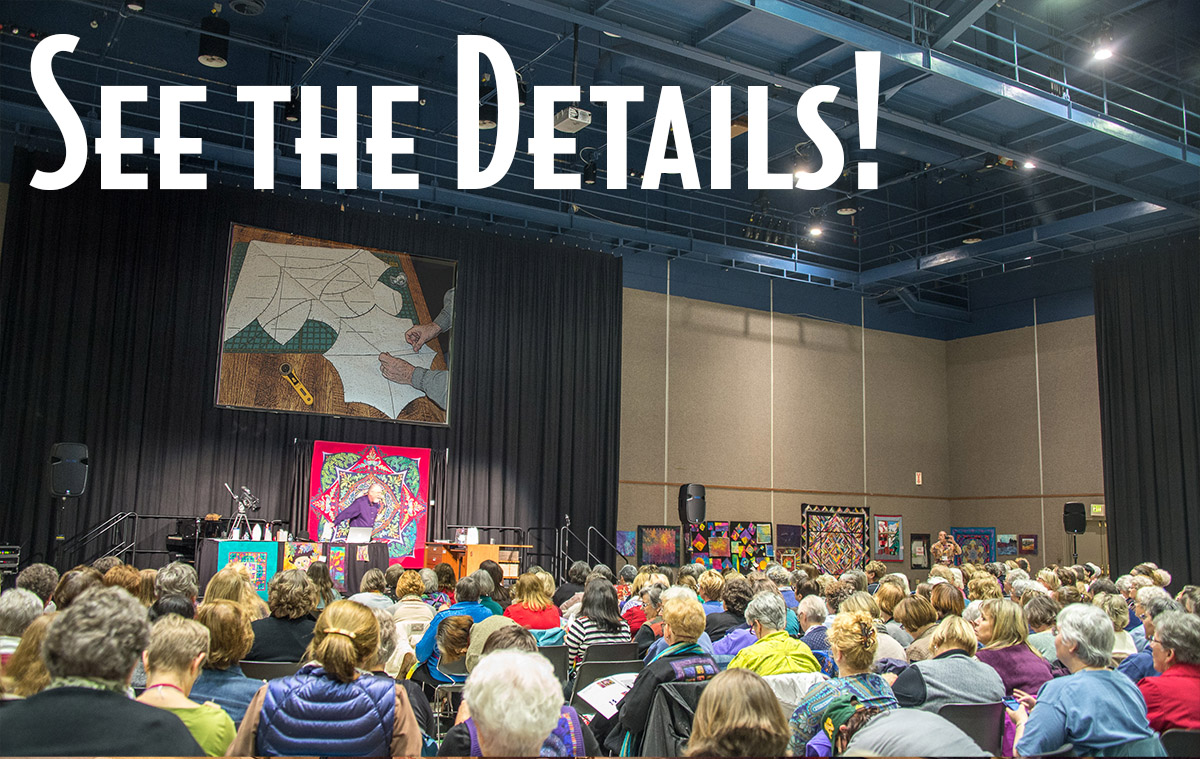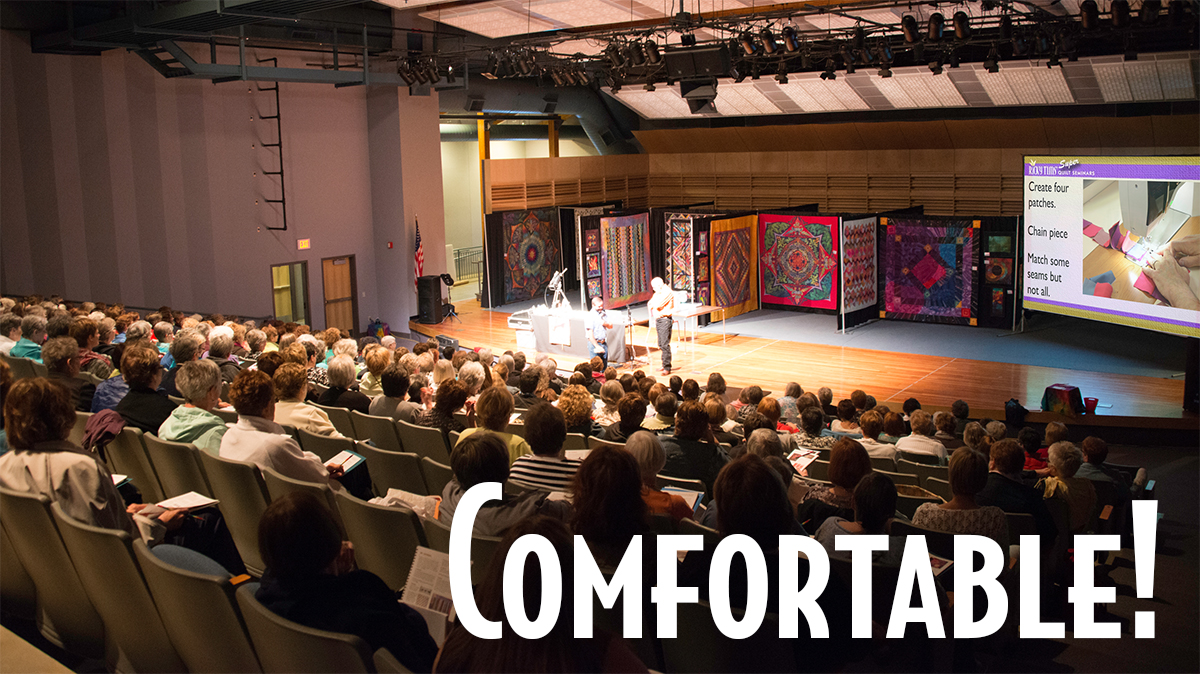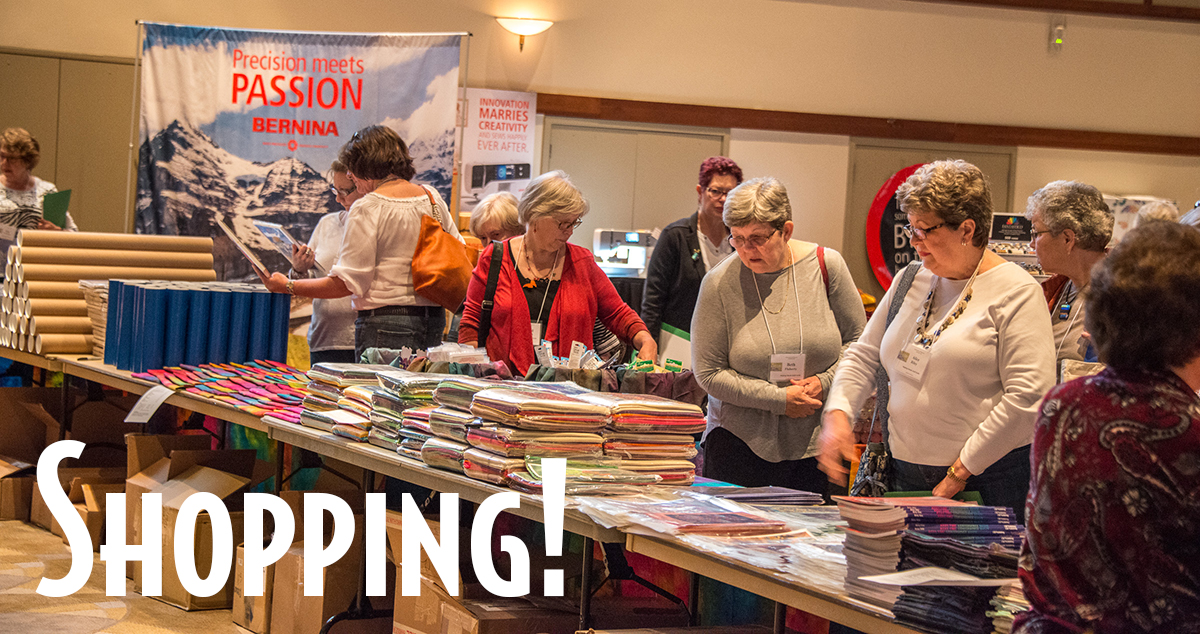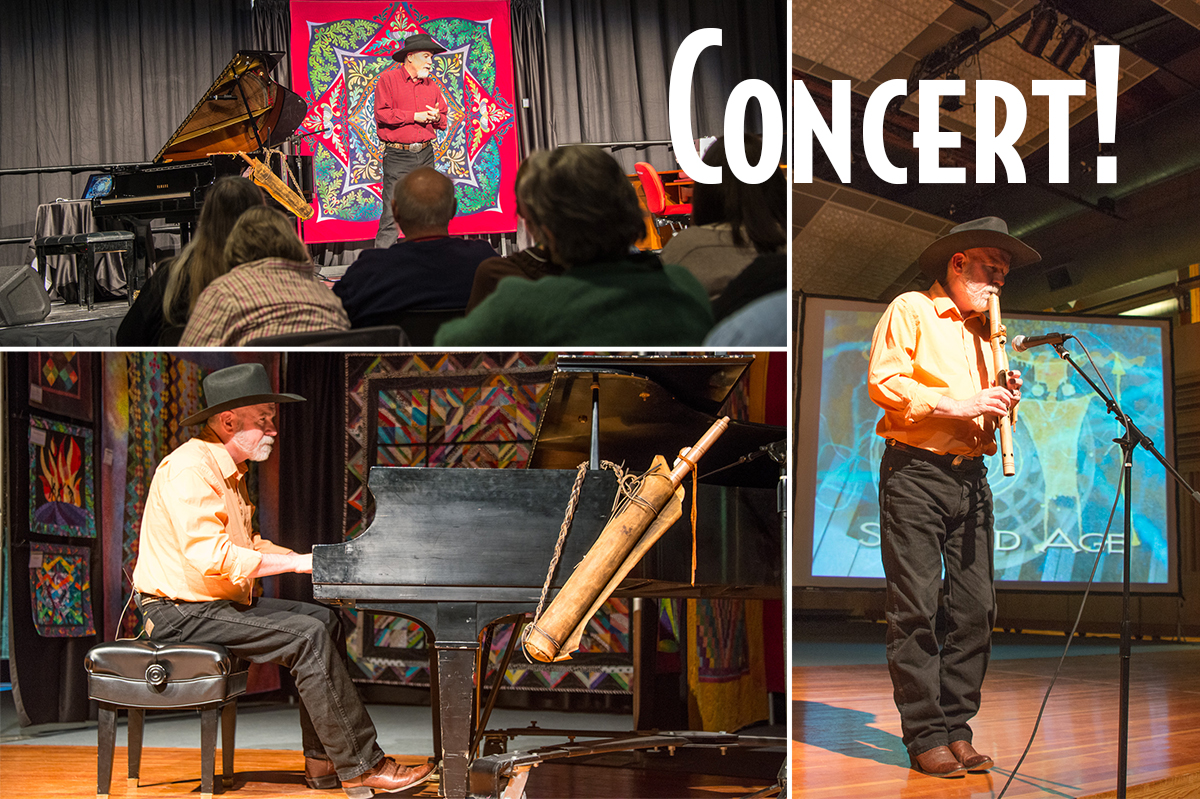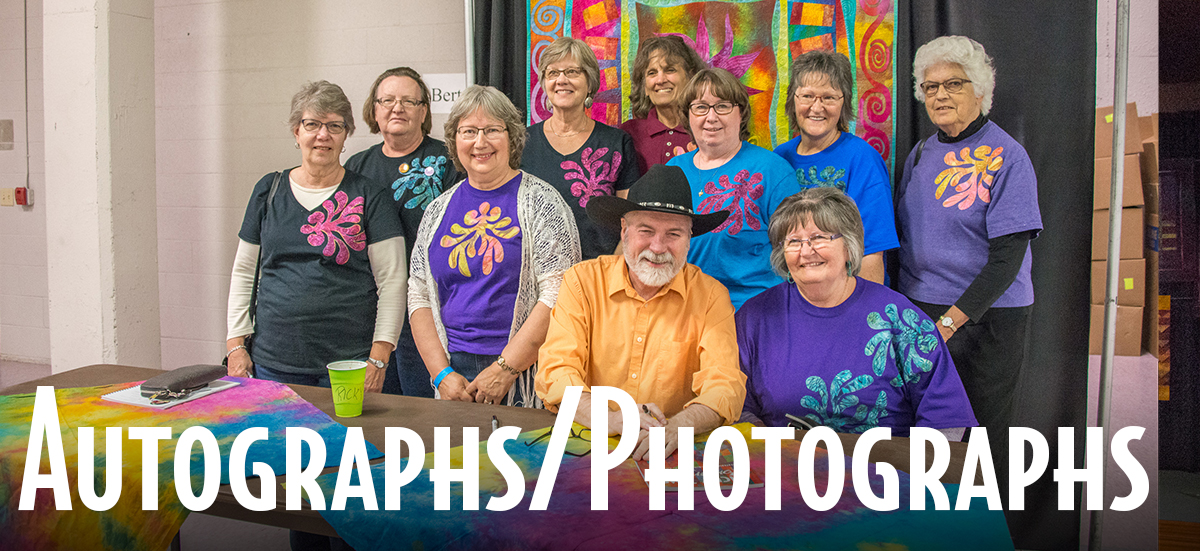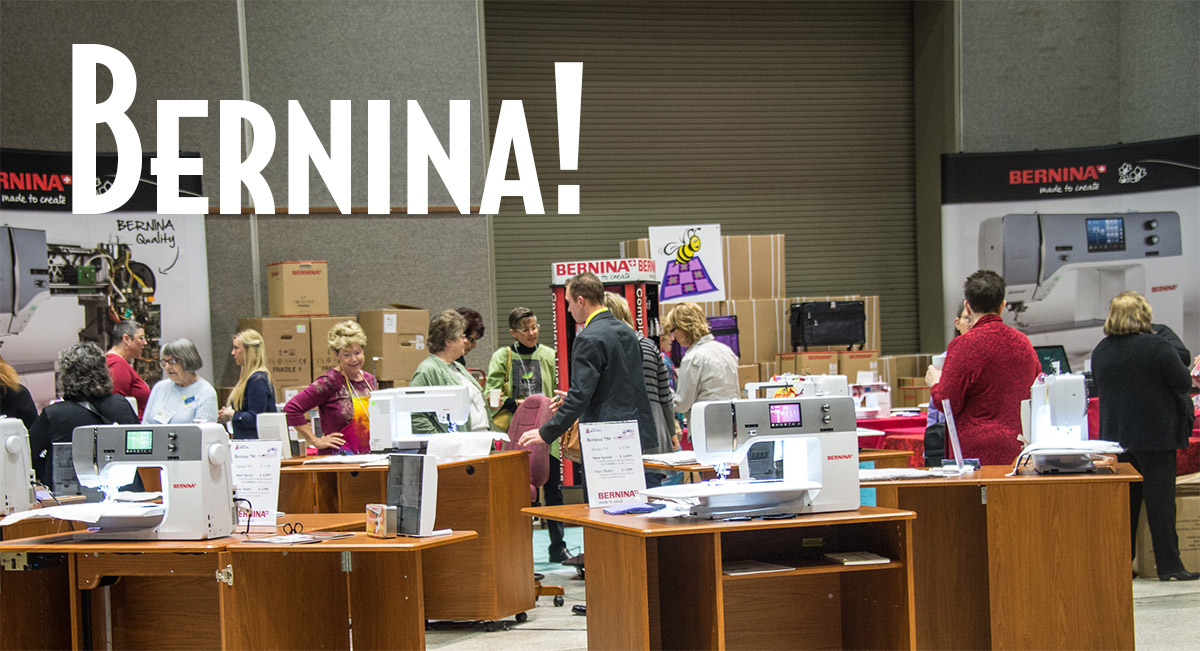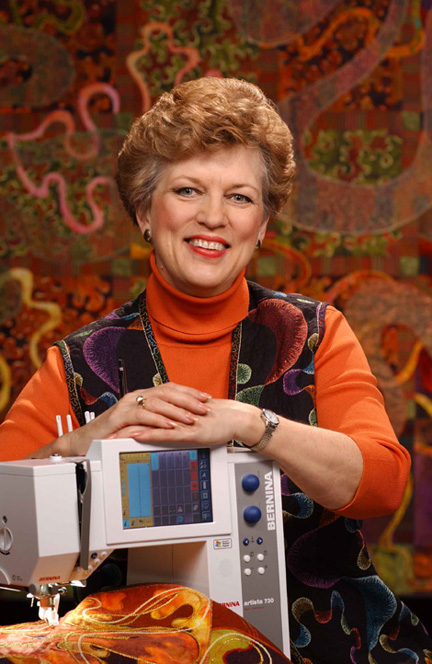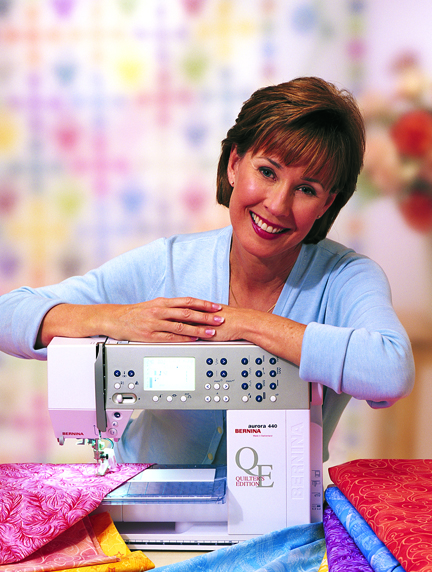|
Ricky Tims – Texan, Musician, Quilter
By Rebecca Collins, North Wales
Reprinted with permission
So reads this man’s business card. Texan: For anyone who IS, this is a very proud boast indeed. They will be very quick to tell you, "Anyone can become an American, but you have to be born a Texan!" Musician: From a very early age Ricky knew that music was to be his life. He recorded his first album at the tender age of five. At university he trained in concert piano performance and the composition of music. He had the great misfortune to have all his university compositions scattered by the wind of a F5 tornado as it swept through his hometown of Wichita Falls, Texas taking with it his and 5000 other family homes. Music continues to be his first love and fortunately for the quilting world he has chosen to combine his composition and performing of music with his quilting activities. Quilter: A close bond with one of his grandmothers ultimately led him into the world of quilting but more about that later when he tells you himself how he became a quilter.
If you were unable to attend the AGM you missed a wonderful weekend. Ricky was the "star turn" for the gala dinner and what a performance he gave us. His magnificent quilt Songe j’Automne hung on the stage for all of us to admire as we ate dinner and socialised with fellow quilters. Much later than was planned he gave us his "Celebrate the Century" perspective of music and quilts. This was a presentation of slides, music, original narrative and song, which covered the 20th Century. His performance was well worth the wait and definitely made the evening and the AGM one to remember. Margaret Menzies will certainly never forget the evening that Ricky Tims knelt beside her and held her hand to sing. (Indeed Margaret could not wait to ring her sister – also a quilter – in Australia to tell her all about the event.)
The first time I became aware of Ricky and his quilts, I was looking at the then current issue of the American Quilter Magazine – the house magazine for the American Quilters’ Society - which had photographs of that year’s prize winning quilts at Paducah. After looking at a particularly stunning quilt, I read who made it. A musician named Ricky Tims. His name leapt off the page. Tims with one "M". I couldn’t believe it.
When Ricky was in this country about two years later, my husband and I travelled to Leicester one evening to hear him give one of his music and quilt presentations. Afterwards when admiring quilters surrounded him and I finally got my chance to speak to him I said that my maiden name was Tims. His automatic response was "Tims with two M’s?" My husband was watching Ricky’s face when I replied, "No with one M." Ricky, like me had never met another Tims - with one "M" - outside immediate family and surprise and disbelief were written all over his face.
The first Tims family to move to Texas was a large one, but did not have too many males to carry on the family name. Because there are so few of us, my father- who had researched our family’s origins - always said, "If it is spelled the same, we must be related." On Ricky’s next trip to the UK he stayed with us for a few days and yes, while talking about family history, it transpires that in all probability we are! Our families during the period of the 1800’s came from the same part of Texas. Ricky says, "I’ve decided we are cousins, even if we can’t prove it yet." What a thrill to discover a relative. Not only another Tims but also one who is a quilter - and a famous one at that!
Ricky’s quilts are stunning and rich in colour. His improvisational approach to design and technique are awe-inspiring. As a quilter and as a teacher he is very generous with his time and knowledge never failing to answer anyone’s question on "how did/do you do that?" He not only strives to encourage but also inspires the members in his classes.
When Vivien asked me to write a Profile on Ricky for The Quilter I knew that others had written much about him in various publications so I thought that I would give Ricky a chance to have his say. I asked him a few questions that I felt sure other quilters would want to ask – if given the opportunity. The following are my questions with the answers in his words, which I was informed, "…are very heart felt".
Question: "For the benefit of those quilters who have not had the pleasure of hearing you speak to a group, how did you get started in patchwork and quilting?"
Answer: "Quilting found me in 1991 while I was working in St Louis, Missouri as a free-lance music producer. I often say being free-lance meant I was unemployed. In fact, I was working but I had more time on my hands than usual. My granny Newsom, an 83 year old widow, living in Texas, was proposed to by a 87 year old man named Pete whom she had known for decades but had not seen or spoken to for several years. Granny immediately accepted his proposal and they were married two weeks later. When she moved to be with him, I inherited her old Kenmore electric sewing machine. Having the machine sparked my curiosity about sewing and I decided to make a western shirt. Someone had told me that shirts were difficult to make so I rethought my decision and instead, decided to make a quilt. No one ever told me that making a quilt was difficult! In June I bought a beginner’s quilting book that had instructions for a 20-block sampler and taught myself following the instructions. That first quilt was made using the technique of cutting and using templates from cereal boxes and then drawing around a template for each piece with a ballpoint pen. At that stage I didn’t know rotary cutters existed. Each block was supposed to be twelve inches finished. My blocks varied from eleven to thirteen inches and it is a wonder that I ever got the quilt to fit together. By the fall (autumn) of 1991 I had learned about a quilt guild in my area and started attending meetings – learning a lot and making quilt friends. The rest is history."
Question: "In terms of style or type of patchwork, where did you start? And where are you going now?"
Answer: "Well, certainly that first quilt was extremely traditional. It contained two or three blocks that had appliqué, but mostly it was pieced. By late summer, I had discovered the rotary cutter and began creating quilts using quick piecing, rotary cutter methods. However, having a creative gene caused me to begin designing my own blocks or creating contemporary settings of traditional blocks. My first quilt is the only quilt that I actually used a pattern or instructions. The rest have all been adaptations of patterns or original designs. The early quilts were also quilted by hand but I quickly discovered that machine quilting was going to be my preferred method of quilting.
I have settled into three main areas of patchwork. The first I call Caveman Style Quilting, which is an improvisational approach, cutting fabrics without templates using gentle curves and allowing the piece to grow as if it had a mind of its own. For precision patchwork I use freezer paper, both as single templates as well as templates which are a foundation to a flip-‘n’-sew process. Finally, my Harmonic Convergence series of quilts features an improvisational flowing patchwork design, which is cut into vertical strips and converged with another piece of patchwork or single piece of multicoloured fabric. I am currently using my own hand-dyed multicoloured fabrics, but there is still the occasion where commercial fabrics are appropriate. I have a few pieces that utilise machine appliqué but most of my work is patchwork. I must admit that the rigorous travel schedule for teaching and lecturing has cut into my creative time, but I do continue to work as much as I can on new pieces and for now I feel what I have to offer as a teacher is important so the sacrifice seems reasonable."
Question: "What do you feel has led you to where you are currently, in terms of your patchwork/quilting and is there anything or anyone that has had any influence on your work?"
Answer: "It has been an amazing road that has brought me to this place. My passion to create has to be listed as the main motivating factor. My appreciation of excellence has driven me to excel to the best of my abilities. I have had several individuals whose encouragement has fuelled my drive and determination. Suzanne Marshall who was a member of my first quilt guild was very inspirational. Her work, which is aesthetically quite different from mine, featured such superior workmanship that it became the standard to which I would aspire. I studied Caryl Fallert’s quilts to gain insight into contemporary design. I know many of my pieces were influenced by her work but now I feel that I’m designing from my own imagination."
Question: "Do you have a favourite technique or type of patchwork and if so which one is it?"
Answer: "I enjoy improvisational work as well as the freezer paper precision technique. The result of each Harmonic Convergence quilt leads me to create another."
Question: "Knowing that music is perhaps your first love, what made you decide to make quilting and quilting related activities a major portion of your life?"
Answer: "Quilting was slowly invading my career as a conductor, composer and producer. The decision to pursue quilting as a profession would never have been made if music had been deleted from the equation. I am fortunate to have found a way to utilise both music and quilting in a unique way. I am fulfilled because each has the ability to feed the other. It is a blessing to be able to do both and call it my profession. However, if anyone asked me what I wanted to do when I grew up, quilting would not have been at the bottom of the list – it would not have even made the list! I encourage individuals to let life happen and expect the unexpected. Life is short – love it fully."
Question: "What led you to begin dyeing your own fabrics?"
Answer: "For the first few years the quilts I most enjoyed at shows often-featured hand-dyed fabrics. I decided to try dyeing fabrics of my own. That was in 1996. I dyed outside during summer months on planks of wood, which were covered with plastic, but only made about 50 yards that year. The following year I began using self-sealing plastic bags and that process was more accessible because I could do it inside. Now I dye in plastic trays in my laundry room. When I dye, which is most days I am home, I do thirty yards a day. Because the fabrics are part of my business I have an assistant who manages every aspect of the dyeing except actually putting the dyes on the fabric – which I do myself."
Question: "Your quilts sometimes look as if the fabric itself has led to the design. Is this the case and do you dye fabric to suit the intended outcome?"
Answer: "It is rare that I dye a fabric for a specific quilt, but my current quilt-in-progress required dye stencilling each piece so those were created specifically for the new quilt. If I need to dye fabrics for a specific quilt it is usually because I don’t have the length needed for piping or binding so I will dye long pieces. (I prefer not to have unnecessary seams if I can avoid them, even on a binding.) I also prefer not to have a seam in the back of my quilt so large quilts often have backings which are dyed from a 108 inch wide fabric. If I don’t have easy access to wide fabric I will piece the back before I dye it and the seam is almost invisible because of the colour movement.
In the case of my quilt, Passage, the floor fabric appears as if I poured on the dyes in a pattern to create the light effect. In actuality, I just auditioned several pieces, which were already dyed, and that particular piece worked perfectly."
Question: "I assume like most quilters that you have a large stash of fabrics purchased over the years. You mentioned earlier that you do occasionally still use fabric that you have not dyed yourself in your quilts but do you still purchase commercial fabrics?"
Answer: "I do have a large stash of fabric, both commercial and hand-dyed. Most of my current work features my own fabrics, but there are still times when commercial fabrics from the stash are appropriate. Yes, I still buy fabric. Isn’t collecting fabrics one of the requirements of a true quilter?"
Question: "No doubt you are tired of hearing this question but how does it feel to be a man in the quilting world when it is considered to be predominately a woman’s domain. Because of this situation, do you feel driven to ‘prove yourself’?"
Answer: "Next to ‘how did I get started making quilts’, this is the second most frequently asked question I receive. I never know exactly what to say. When I attended my first quilt meeting ten years ago, I was timid, and felt a little bit awkward. However, the ladies welcomed me with open arms. They were willing to share their tips and insights and encouraged me to keep on going. I did feel that I had to prove myself. There’s no doubt that when I took a quilt to a show-and-tell, it was scrutinised, but that was good for me. It drove me to excellence. I wanted to learn all the rules – and I think I did – but now I break a lot of rules. My quilting techniques are still very recognisable even if they are contemporary or unorthodox. I think that is what has helped me to gain the respect of these wonderful ladies. I stopped thinking about the gender issue a long time ago. I have become part of a community of quilters, creative individuals, people who have good days and bad days, those who celebrate victories and grieve losses, artisans whose well-spring of inspiration is sometimes full and sometimes dry. So ask me again, ‘How do I feel being a man in a field dominated by women?’ I feel accepted, respected, privileged, honoured, blessed and lucky to be a part of the incredible worldwide quilting community."
Question: "To quell the rumours of the bush telegraph/jungle drums, please give us a brief account of your recent heart surgery? Has this slowed you down or given you a ‘new lease on life’?"
Answer: "In April 2000, a few days before attending the American Quilter’s Society Quilt Show and Contest in Paducah, Kentucky, I began experiencing pain in my chest when walking. I dismissed it as a pulled muscle and went on to the show. The first day of the show I was convinced that I needed medical attention and was taken to the emergency room for examination. Nothing was found to indicate a problem, but the pain continued to worsen throughout the week leaving me almost unable to walk, even slowly, without pain. Upon arriving home from the show I immediately saw my doctor who sent me to a cardiologist for testing. The tests indicated a significant abnormality. I was told that I must have quadruple heart bypass surgery to survive. Thankfully, I didn’t have a heart attack. I recovered very quickly from the surgery. I was home after just five days and I began working on my commemorative heart quilt, The Beat Goes On, by day eight. Have I slowed down? No. Not really. I spend more time doing the things I want to do. I moved near Denver, Colorado, close to the mountains. I take each day as a gift and try to spend it wisely. I still want to inspire and encourage others so I count it a blessing that I’ve been given more time to do so. The most important thing I did after my surgery was to make a solo piano recording. Heart and Soul, which is somewhat of a chronicle of my life. Many of the pieces are original compositions, but I also included arrangements of hymn tunes and familiar folk songs such as Danny Boy."
Question: "And finally, do you have a quilting related ultimate goal, if so; do you care to share it with our readers?"
Answer: "I have many goals that are quilt related, some which will remain private. One of my goals has recently become a reality. I had hoped to establish an international quilt retreat in a destination-oriented place where I would be given the opportunity to spend a week with students who desire to develop both artistically and personally. In October of 2001, twenty-five students will join me at Glen Eyrie Castle near Colorado Springs, Colorado for the first Rocky Mountain Quilt Retreat. It promises to be the ‘most enchanting quilt retreat ever!’ It will always remain small so that the group can be focused and receive personal attention. Beyond that, I hope that I can continue to share my passion for quilting, with others, for many more years."
If you have not had the opportunity to attend a lecture given by Ricky you have missed a rare treat. His mixture of music, quilts and humour make for a very informative and entertaining event. The way that he combines his two creative skills – music and quilting - makes you look at quilts in a completely new light. You will never look at any quilt in the same way again. He makes you see things within the quilt that perhaps the makers were not even aware of when they made them. Having "tuned into" this analytical yet emotional and intuitive way of viewing, it will also affect how you see everyday things around you, making for a much more rewarding way to experience life.
|

